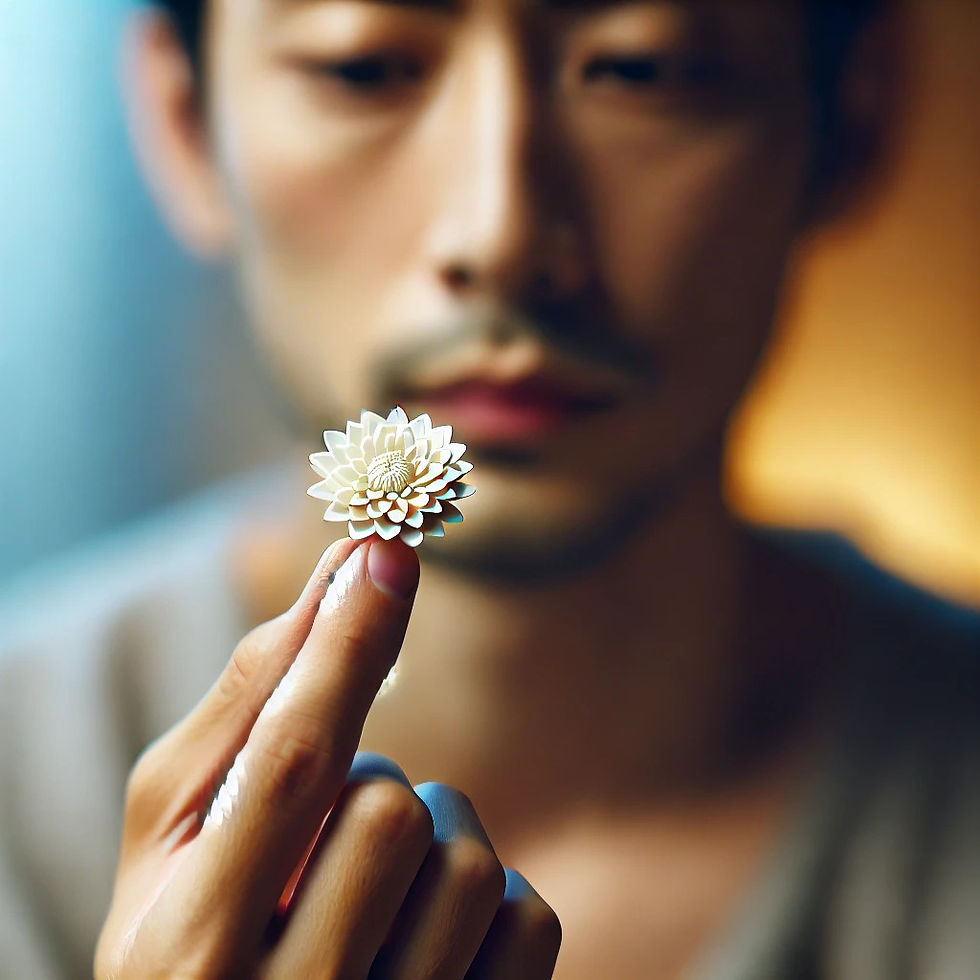Mindfulness for Beginners: Simple Steps to Transform Your Life
- amit shemesh
- Nov 14, 2024
- 16 min read
Hello everyone, and welcome to our journey into the transformative world of mindfulness. Today, we're diving into the simple, yet profound steps you can take to begin changing your life through mindfulness. Whether you're a complete novice to this practice or simply looking to deepen your understanding, this guide is designed to help you start with practical and easy-to-implement techniques.
Mindfulness—it's a term that's gained popularity, but what does it really mean? At its core, mindfulness is about being fully present in the moment, engaging fully with the here and now without distraction or judgment. It's about not letting your runaway thoughts and emotions control your day-to-day life. Imagine listening to this not just to hear, but to truly absorb without preconceptions about how it's said or the unrelated tasks of your day.
By adopting a mindful approach, you can begin to notice significant shifts in your stress levels, your joy, and your overall emotional resilience. The beauty of mindfulness lies in its simplicity and accessibility—you don't need any special equipment or a secluded mountain retreat. You can start right where you are, at this very moment.
So, why should you consider integrating mindfulness into your life? Studies show that individuals who practice mindfulness report lower levels of stress and anxiety, enhanced joy, and a greater ability to manage emotions. But more than just feeling better, mindfulness can fundamentally change the way you engage with the world, enriching your experiences and improving your overall quality of life.
Ready to embark on this life-changing path? Let's explore how simple it can be to step into a more mindful state of being, and how even the smallest practices can lead to profound joy and discovery.
What is Mindfulness?

Mindfulness is a practice rooted in ancient traditions, yet perfectly suited to our modern lives. It involves cultivating a state of awareness and presence in every moment. When we talk about being mindful, we are referring to the ability to remain grounded in the here and now, fully engaging with our current experiences without distraction or judgment.
At its simplest, mindfulness means paying attention on purpose. It's about noticing your environment, your thoughts, your feelings, and your bodily sensations without trying to change them. This might sound straightforward, but in our fast-paced world, where multitasking and digital distractions are the norm, giving your full attention to the present moment can be surprisingly challenging.
Being Present
Imagine you’re listening to a friend, watching a sunset, or even reading this article. Mindfulness encourages you not to think about what you’ll have for dinner or replay a conversation from earlier in the day. Instead, it's about focusing on the now—listening actively, observing the rich colors of the sunset, or engaging deeply with these words. It’s about letting go of the past and the future to embrace the present fully.
Observing Without Judgment
One of the fundamental aspects of mindfulness is observing your present experience without criticism. Often, we label our experiences as "good" or "bad," which can lead to stress and emotional turmoil. Mindfulness teaches us to observe our thoughts and feelings without labeling them, which provides a chance to understand ourselves better and connect with a deeper sense of peace.
Awareness of Thoughts and Emotions
Mindfulness also involves an increased awareness of our thoughts and emotions as they happen. By observing our mind's activity from a distance, we gain the power to respond to situations with clarity and wisdom rather than reacting out of habit or impulse. This awareness allows us to break free from the automatic thought patterns that can dominate our lives, such as fears, anxieties, and prejudices.
Benefits of Mindfulness
The practice of mindfulness has been scientifically proven to have significant benefits. It reduces stress, alleviates anxiety, improves focus, boosts creativity, and enhances our overall emotional and physical well-being. People who practice mindfulness regularly often report feeling less overwhelmed, more in control, and more attuned to their personal and professional lives.
In essence, mindfulness is not just a meditation practice but a way of living. It's about making a conscious choice every moment to be present and aware, no matter what you're doing. As we continue to explore mindfulness, we'll delve into how you can incorporate this transformative practice into your daily routine to experience its profound benefits firsthand.
The Immediate Benefits of Mindfulness

Embracing mindfulness can bring about significant changes in your mental, emotional, and physical well-being. While the transformative effects of mindfulness deepen over time, there are several immediate benefits that you can begin to experience from the very first day of practice. Here’s a look at some of the most impactful:
1. Reduced Stress and Anxiety
One of the most notable benefits of mindfulness is its ability to reduce stress and anxiety levels. By focusing on the present moment, mindfulness calms the mind and reduces the overactivity that often leads to anxiety and stress. Regular mindfulness practice teaches you to handle stressful situations more calmly and effectively, thereby reducing the overall impact of stress on your life.
2. Enhanced Emotional Resilience
Mindfulness increases your awareness of your emotional reactions and gives you the tools to manage them more effectively. Instead of being overwhelmed by emotions, mindfulness allows you to observe them without judgment and respond from a place of rationality and calm. This enhanced emotional resilience can improve relationships, workplace interactions, and your overall sense of well-being.
3. Improved Focus and Concentration
In a world full of distractions, mindfulness helps sharpen your focus and concentration. By training your mind to be present, you develop the ability to concentrate your attention more effectively. Whether it’s completing a work assignment, studying for an exam, or engaging in a hobby, mindfulness enhances your ability to stay engaged and less prone to distractions.
4. Better Sleep
Mindfulness techniques, especially those that involve mindfulness-based stress reduction (MBSR) or mindfulness-based cognitive therapy (MBCT), can significantly improve sleep patterns. By reducing the mental chatter and easing the tension in your body, mindfulness helps you achieve a state of relaxation conducive to a good night’s sleep.
5. Increased Joy and Satisfaction
Mindfulness fosters an appreciation for the small moments that make up your day. By being fully present, you begin to find joy in everyday activities and interactions, which might otherwise go unnoticed. This shift in perspective can dramatically increase your overall satisfaction with life.
6. Enhanced Physical Health
The benefits of mindfulness extend beyond mental and emotional improvements; they also include physical health benefits. Studies have shown that mindfulness can help reduce chronic pain, lower blood pressure, and improve immune system function. By reducing stress, which is often a contributor to numerous physical ailments, mindfulness practices can lead to better overall health.
These benefits represent just the tip of the iceberg when it comes to the positive changes that mindfulness can bring into your life. As we explore further into how to practice mindfulness, you’ll see how these benefits can become a sustained part of your everyday experience, ultimately leading to a more fulfilling and balanced life.
How to Start Practicing Mindfulness Today

Starting a mindfulness practice doesn't require special equipment or a lot of time. You can begin right now, wherever you are, with some simple techniques that can be seamlessly integrated into your daily life. Here’s how to get started with practical steps that can help foster mindfulness:
1. Mindful Breathing
The foundation of mindfulness practice is mindful breathing. Simply focus on your breath: notice the air entering and leaving your nostrils, or the rise and fall of your chest. When your mind wanders, gently bring your attention back to your breath. This can be done for just a few minutes each day to help center your mind and reduce stress.
2. Sensory Observation
Choose one of your senses to focus on for a few minutes. For instance, you might spend a few minutes just listening to the sounds around you, or observing the details in your environment that you usually overlook. This practice helps anchor you in the present moment and sharpens your focus.
3. Body Scans
Lie down in a comfortable position and slowly bring your attention to different parts of your body. Start from your toes and move upwards. Notice any sensations, tension, or discomfort. This not only increases bodily awareness but also highlights areas of stress that you may not have been consciously aware of.
4. Mindful Eating
Turn your meals into a practice of mindfulness. Eat slowly, chew thoroughly, and savor each bite. Notice the textures, the flavors, the temperatures, and the smells. Mindful eating can enhance your enjoyment of food and help prevent overeating by improving your recognition of satiety.
5. Mindful Walking
Whether you are walking to your car, around your office, or in a park, focus on the experience of walking. Feel your feet touching the ground, the rhythm of your steps, and the sensations in your legs and arms as you move. This transforms a simple activity into a profound exercise in mindfulness.
6. Mindful Listening
When talking to someone, focus completely on what they are saying. Listen without planning what you’ll say next. Notice their expressions, tone of voice, and your own reactions and feelings as they speak. This can lead to deeper connections and more effective communications.
7. Regular Mindfulness Meditation
Set aside a regular time each day for mindfulness meditation. It can be as short as five minutes. The key is consistency. Over time, this practice will deepen your overall mindfulness skills and increase your ability to stay present throughout the day.
8. Use Mindfulness Reminders
Set reminders on your phone or place sticky notes in your home or workspace to pause and practice mindfulness. These reminders can help bring you back to the present moment, especially during busy or stressful times.
Starting to practice mindfulness is about small, manageable steps. It’s not about perfection or completely clearing your mind of thoughts. It’s about becoming more aware of the present moment, in whatever form it takes. As you incorporate these practices into your daily life, you’ll likely notice a shift in how you relate to yourself and the world around you.
Common Challenges and How to Overcome Them

Starting and maintaining a mindfulness practice can be rewarding, yet it's not without its challenges. Understanding these common hurdles and knowing how to navigate them can help you stay committed to your mindfulness journey. Here are some typical challenges and strategies to overcome them:
1. Finding Time
Challenge: One of the most common barriers is finding time in a busy schedule to practice mindfulness.
Solution: Incorporate mindfulness into activities you’re already doing. Practice mindful breathing while waiting in line, mindful walking to your car, or mindful listening during conversations. You don’t need to carve out large chunks of time; even a few minutes can be beneficial.
2. Dealing with Distractions
Challenge: It can be difficult to maintain focus with constant interruptions from technology, people, or your own wandering thoughts.
Solution: Acknowledge distractions without judgment and gently redirect your focus back to the mindfulness practice. Over time, you’ll find it easier to sustain your attention. Consider setting specific times or spaces where you minimize potential interruptions, such as early morning or a quiet corner in your home.
3. Feeling Like You’re Not Doing It Right
Challenge: Many beginners worry that they are not practicing mindfulness "correctly," especially if they don’t feel immediate peace or enlightenment.
Solution: Understand that mindfulness is not about achieving a state of bliss but rather about being present with whatever you are experiencing, even if it's discomfort or restlessness. There is no right or wrong way to be mindful. The key is consistency and effort.
4. Physical Discomfort
Challenge: Sitting or staying still for mindfulness exercises can sometimes be physically uncomfortable or challenging.
Solution: Use a comfortable posture for meditation. You don’t have to sit cross-legged on the floor; you can sit on a chair, lie down, or even walk. Make sure whatever position you choose is sustainable for the duration of your practice.
5. Impatience and Frustration
Challenge: Some may become impatient with the slow progress or frustrated when they do not see benefits quickly.
Solution: Set realistic expectations and remember that the benefits of mindfulness practice can be subtle and cumulative. Celebrate small victories, like noticing when your mind has wandered and bringing it back to the present. Mindfulness is a skill that develops over time with regular practice.
6. Emotional Overwhelm
Challenge: Sometimes, increased awareness can lead to confronting emotions or thoughts that you’ve been avoiding.
Solution: If intense emotions arise, consider working with a mindfulness coach or therapist who can guide you through these experiences safely. Learning to stay with difficult feelings in a compassionate and non-judgmental way is a profound aspect of mindfulness practice.
7. Maintaining Consistency
Challenge: It's common to start with enthusiasm and then see it wane over time or struggle to practice regularly.
Solution: Commit to a specific, manageable amount of time each day, even if it's just five minutes. Joining a mindfulness group or finding a practice buddy can also provide motivation and accountability. Use apps or alarms as reminders to practice.
Understanding and anticipating these challenges can make your mindfulness practice more resilient and adaptable. By employing these strategies, you can cultivate a mindfulness routine that not only fits your lifestyle but also sustains and grows with you over time.
Introducing the Bwake Ring: Your Mindfulness Companion

As you embark on your mindfulness journey, having the right tools can enhance your practice and help you remain consistent. The Bwake Ring is designed to be your personal mindfulness companion, providing you with the support you need to stay present and mindful throughout your day. Here’s how this innovative tool can be an integral part of your mindfulness routine:
What is the Bwake Ring?
The Bwake Ring is a smart wearable device designed with mindfulness in mind. It features a discreet, stylish design that suits any lifestyle and is equipped with technology that aids in maintaining and enhancing mindfulness practices. The ring's core functionality revolves around a simple yet powerful concept: a touch button that you press to return your focus to the present moment.
How Does It Work?
Touch Button: At its heart, the Bwake Ring has a touch-sensitive button that you press during your mindfulness exercises. Each press helps you mark a breath or a moment of awareness, anchoring you in the present. This tactile feedback is designed to bring your attention back to the moment, especially useful during busy or stressful times.
Breath Tracking: The Bwake Ring tracks your breathing patterns when you press the button. This feature allows you to become more aware of your breath, which is a central aspect of many mindfulness practices. It helps you maintain a rhythmic pattern that enhances deep relaxation and focus.
Vibration Alerts: If the ring senses that you haven’t engaged in mindful breathing for a set period, it gently vibrates. This subtle nudge is not intrusive but is just enough to remind you to refocus your awareness on the present moment, making it easier to build a habit of continuous mindfulness.
Benefits of Using the Bwake Ring
Continuous Mindfulness Support: With the Bwake Ring, mindfulness doesn’t have to be confined to a meditation cushion. Whether you are at work, in a meeting, or doing household chores, the ring provides gentle reminders to remain mindful, helping you integrate mindfulness seamlessly into every part of your day.
Enhanced Focus and Calm: Regular use of the Bwake Ring can help enhance your focus and calm by making mindfulness practice more accessible and immediate. It reduces the effort needed to remember to practice mindfulness, allowing you to achieve deeper states of calm and focus with less effort.
Track Your Progress: The accompanying app not only allows you to track your breathing and mindfulness sessions but also offers insights into your progress. Over time, you can see how your mindfulness practice has improved your daily life, providing motivation to continue and deepen your practice.
Easy Integration: The Bwake Ring is designed to integrate easily into your daily life without disruption. Its user-friendly interface and discreet vibrations ensure that your journey towards mindfulness is supported in the most convenient way possible.
Getting Started with the Bwake Ring
To begin using the Bwake Ring, simply wear it on any finger that feels comfortable. Start by using the touch button during dedicated mindfulness sessions, and gradually incorporate its use throughout your day. The goal is to make mindfulness an accessible, integrated part of your life, supported and enhanced by technology.
The Bwake Ring represents a fusion of technology and traditional mindfulness practice, providing a modern solution for a timeless pursuit—greater awareness and presence in every moment of your life.
How the Bwake Ring Enhances Mindfulness Practice

The Bwake Ring is not just a wearable device; it's a carefully designed tool that supports and enhances your mindfulness practice. Its unique features make it an invaluable companion for anyone looking to deepen their mindfulness and maintain a consistent practice. Here’s how the Bwake Ring can transform your daily mindfulness routine:
1. Immediate Mindfulness Activation
The Bwake Ring’s primary feature is the touch button, which serves as an instant reminder to focus and return to the present moment. Whether you're feeling overwhelmed at work or distracted at home, a simple press of the button can help center your thoughts and calm your mind. This immediate activation is crucial in training your brain to recognize and shift towards mindfulness more quickly over time.
2. Enhanced Breath Awareness
Breathing is a central element of mindfulness practice, and the Bwake Ring enhances this by tracking your breath cycles. By pressing the button with each breath, you not only remind yourself to breathe deeply but also engage actively with the breathing process. This conscious engagement helps to deepen your breath, which is known to reduce stress and improve cognitive function.
3. Subtle, Mindful Reminders
The gentle vibrations from the Bwake Ring serve as subtle cues to bring your attention back to the present moment. These reminders are especially useful during busy days when mindfulness might otherwise be neglected. By providing these gentle nudges, the Bwake Ring helps integrate mindfulness into your daily life, ensuring that you remain grounded and focused no matter the situation.
4. Tracking and Feedback
With the Bwake Ring's connected app, you can track your mindfulness sessions and monitor your progress over time. This feature allows you to see tangible evidence of how often you engage in mindfulness practice and its effects on your mood and productivity. The feedback can be incredibly motivating, as it shows the direct impact of consistent mindfulness on your overall well-being.
5. Mindfulness On-the-Go
The Bwake Ring's portability means you can bring your mindfulness practice with you anywhere. Whether you’re traveling, at the office, or running errands, the ring is always with you, providing an opportunity to practice mindfulness. This portability ensures that your mindfulness practice is not limited to a specific place or time, making it more adaptable to your lifestyle.
6. Integration with Daily Activities
The Bwake Ring makes it easier to incorporate mindfulness into everyday activities. From mindful eating to mindful walking, the ring’s presence on your finger serves as a constant reminder to engage fully with the present moment. This integration transforms routine activities into opportunities for mindfulness practice, enhancing the quality of your daily life.
7. Support for Deep Meditation
For those who engage in structured meditation sessions, the Bwake Ring can enhance the depth and focus of these practices. By using the ring to mark the start and end of a meditation session or to maintain focus on breathing, it supports deeper and more focused meditation, helping you achieve a greater sense of calm and clarity.
The Bwake Ring is designed to be a seamless addition to your life, supporting and enhancing mindfulness practice without being intrusive. Its intuitive design ensures that staying mindful becomes a more accessible and regular part of your day, ultimately leading to improved mental, emotional, and physical health.
Incorporating Mindfulness into Everyday Activities

Mindfulness doesn't have to be confined to meditation sessions; it can be woven into the fabric of your daily life. Incorporating mindfulness into routine activities can transform mundane tasks into moments of presence and awareness, enriching your everyday experience. Here’s how you can infuse mindfulness into various aspects of your day:
1. Mindful Morning Routine
Start your day with intention. Instead of rushing through your morning, take a few moments to breathe deeply and set intentions for the day. Whether it’s while brushing your teeth, showering, or having your morning coffee, focus fully on the task at hand. Notice the sensations, the smells, the tastes, and the sounds, bringing full awareness to these simple actions.
2. Mindful Commuting
Turn your commute into a practice of mindfulness. If you’re driving, focus on the feel of the steering wheel, the sight of the road, and the sounds around you. If you’re using public transport, use this time to observe your breath or listen to the sounds around you without judgment. This practice can turn a potentially stressful commute into a refreshing transition between home and work.
3. Mindful Workday
Integrate mindfulness into your workday by taking short mindfulness breaks. Before starting a new task, pause for a moment to breathe deeply and center yourself. Use the Bwake Ring to remind you to take these pauses. This can help you maintain focus and efficiency, reduce work-related stress, and improve your overall job satisfaction.
4. Mindful Eating
Make meals an opportunity for mindfulness. Eat slowly and without distractions like TV or smartphones. Pay attention to the taste, texture, and aroma of your food. This not only enhances your dining experience but can also help with digestion and prevent overeating by increasing your awareness of satiety cues.
5. Mindful Walking
Whether you’re walking to a meeting or taking a stroll during your lunch break, engage fully with the experience of walking. Feel each step, notice your breath, and observe your surroundings without rushing. This simple practice can help clear your mind and connect you with the environment, providing a refreshing break in your day.
6. Mindful Listening
When engaging in conversations, practice active listening. Focus completely on the other person, listening to their words without planning what you will say next. This not only improves communication but also deepens your relationships and makes interactions more meaningful.
7. Mindful Evenings
End your day with mindfulness. Spend some time reflecting on the day, journaling, or practicing gratitude. Engage in a relaxing activity like reading or listening to soothing music with full attention. This can help you wind down effectively, setting the stage for a good night’s sleep.
By incorporating mindfulness into these everyday activities, you can significantly enhance your awareness and enjoyment of the present moment. These practices help cultivate a state of mindfulness that doesn’t feel like a chore but rather a natural part of your daily life, supported and enhanced by tools like the Bwake Ring. This approach not only improves your mental and emotional well-being but also deepens your connection to the world around you, making everyday life richer and more fulfilling.
Conclusion

Embarking on a mindfulness journey is a profound step towards enhancing your quality of life. By embracing mindfulness, you are choosing to live in the present, appreciate each moment, and manage your mental and emotional health with awareness and grace. The practices and techniques discussed in this article are your starting points, simple yet powerful tools that can lead to significant changes in how you perceive and interact with the world.
The Bwake Ring, as we've explored, can be a transformative tool in this journey. It's designed not just to remind you to be mindful but to integrate mindfulness seamlessly into every aspect of your day. Whether you're responding to stress, engaging in daily activities, or seeking moments of peace, the Bwake Ring is there to guide you back to the present moment.
Remember, the goal of mindfulness isn't to perfect your technique or to achieve a state of constant peace. Instead, it's about developing a deeper understanding of yourself and learning to exist within the present moment without judgment. This journey is unique to each individual, and each small step is a part of a larger path towards a more mindful, fulfilling life.
We encourage you to take what you've learned and start applying it. Let mindfulness be more than just a practice—let it be a way of life. Engage with it daily, reflect on your experiences, and be patient with yourself as you grow. Mindfulness is a skill that develops and deepens over time, with each practice bringing its own set of challenges and rewards.
Thank you for taking the time to explore the possibilities of mindfulness. We are excited to see how this journey unfolds for you. Remember, we are here to support you, whether through our community, resources, or the Bwake Ring. Together, let's embrace the present and discover the peace and joy that come from truly living in the moment.



Comentarios